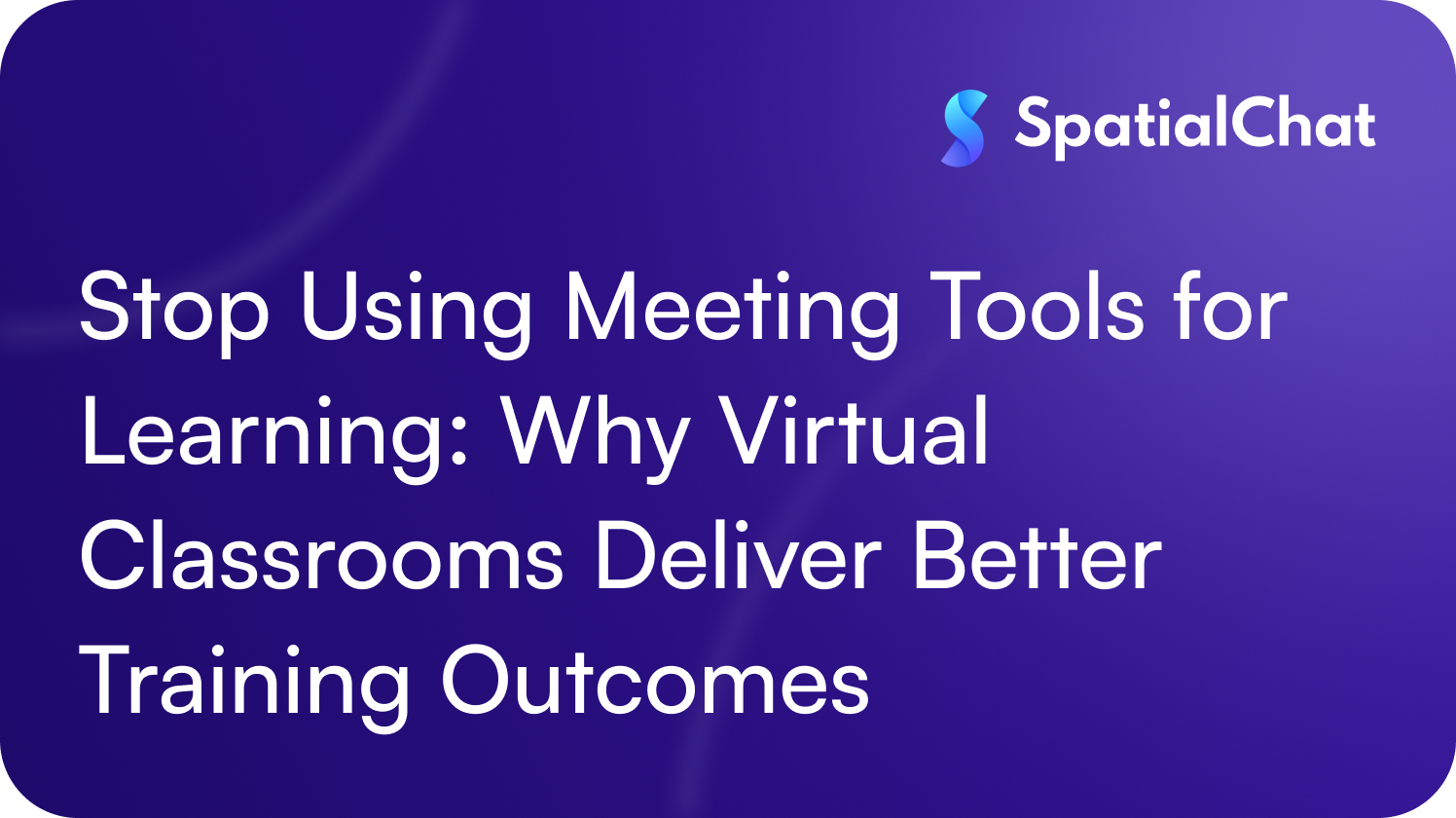Stop Using Meeting Tools for Learning: Why Virtual Classrooms Deliver Better Training Outcomes

In a competitive business environment, staying ahead means continually investing in your team’s growth. For organizations with distributed workforces, this means finding training solutions that are not only scalable, but also effective and engaging. That’s where virtual classrooms come in. Unlike standard meeting platforms, they’re built specifically to support learning, offering greater flexibility, faster skill development, and more meaningful learner engagement across time zones and teams.
Yet, despite the clear advantages, many companies still rely on traditional web conferencing tools to deliver training. Often, it’s out of habit or convenience, since these tools are already available and familiar. But while they may work fine for meetings, they fall short when it comes to creating impactful learning environments.
Why Meeting Platforms Miss the Mark for Learning
At a glance, meeting software seems like a viable option for training. But when put to the test, several shortcomings and limitations that can hinder both trainers and learners become apparent.
- Low Learner Engagement: Meeting platforms weren’t designed for interactive education. They often lack the tools needed to keep learners engaged, such as real-time collaboration features, dynamic breakout spaces, or embedded assessments. Without these, sessions become passive, and attention spans wane.
- Training Inefficiencies: Trainers need to adapt content, adjust pacing, and deliver sessions smoothly. Standard web conferencing tools make this difficult. Limited multimedia support, clunky breakout room management, and minimal learner visibility often force instructors to spend more time managing logistics than teaching.
- Limited Instructor Control: Managing participation in large virtual sessions can be a challenge. Instructors may struggle to gauge learner involvement, keep everyone on track, or offer personalized feedback, all of which are essential for an effective training experience.
- Poor Scalability: As your team grows, so do the logistical hurdles. Sharing the right content with the right people, ensuring consistent delivery, and maintaining engagement becomes increasingly difficult without a solution purpose-built for learning at scale.
Purpose-built virtual classrooms, like those enabled by platforms such as SpatialChat, solve these challenges by offering an immersive, collaborative, and scalable environment. When you shift from simply hosting meetings to designing real-time learning experiences, you unlock deeper engagement and stronger outcomes across your teams.
The Virtual Classroom Edge: Why Purpose-Built Platforms Drive Better Learning
When your goal is to deliver training that’s memorable, measurable, and meaningful, standard meeting tools simply don’t cut it. Purpose-built virtual classrooms are designed from the ground up to support learning, not just communication. With built-in features that promote engagement, personalization, and scalability, these platforms streamline the training process and help teams apply what they learn faster.
Here are four key advantages that set virtual classrooms apart:
1. Built for Learning, Not Just Communication
Unlike general-purpose meeting tools, virtual classrooms come equipped with interactive features like live polls, quizzes, collaborative whiteboards, and persistent content sharing. These tools keep learners actively involved, while AI-powered personalization and adaptive learning options help tailor the experience to each individual’s needs.
2. Enhanced Instructor Control and Real-Time Insights
Virtual classrooms empower facilitators with better oversight, allowing them to lock browser tabs to minimize distractions, track real-time participation, and analyze performance data. These insights help identify who’s engaged, who might be falling behind, and where content can be refined for better outcomes.
3. Scalable for Distributed and Global Teams
Whether you’re training five people or five hundred, virtual classrooms offer the tools to scale effectively. With standardized content delivery, localization options for multilingual teams, and automated recordings, learners can revisit sessions on their own schedule. Integration with learning management systems (LMS) ensures structured learning paths, task tracking, and seamless content access, both during and after the session.
4. Designed to Drive Knowledge Retention and Application
Active learning is central to effective training. Through breakout discussions, hands-on activities, and real-time simulations, learners build skills they can use immediately. Structured feedback and built-in assessments help reinforce those skills, offering a continuous loop of learning and improvement.
Virtual classrooms aren’t just a digital replacement for in-person training. They’re a smarter, more impactful way to build knowledge across your organization.
The Business Case for Virtual Classrooms
For learning and development leaders, virtual training platforms aren’t just a convenience, but a strategic advantage. By enabling scalable, high-quality training at a lower cost, these solutions deliver measurable gains in both productivity and performance.
Organizations that adopt virtual classrooms report up to a 50% boost in productivity, thanks to faster onboarding and accelerated upskilling. Employees ramp up quicker, reducing the time it takes to reach full contribution. And with standardized, consistent training across teams and regions, companies ensure a uniform learning experience, no matter where their workforce is based.
Beyond efficiency, the impact is long-term. Virtual training drives better knowledge retention, higher engagement, and more meaningful skill development. This translates to reduced turnover, stronger team performance, and ultimately, a more competitive and future-ready workforce.
Future-Proofing Training Starts Now
Investing in a purpose-built virtual classroom is more than a tech upgrade. It’s a commitment to smarter, more agile learning. The faster your team learns, the faster your business grows. Now is the time for L&D leaders to rethink training delivery and choose tools built for impact.
Want to see what that looks like in action? Speak with a SpatialChat expert today!